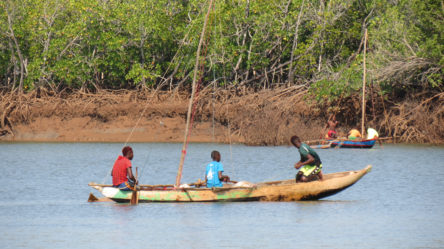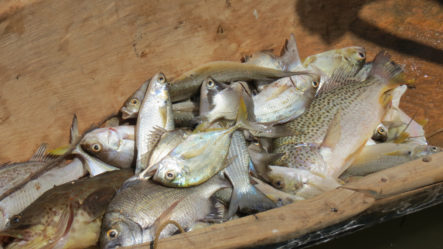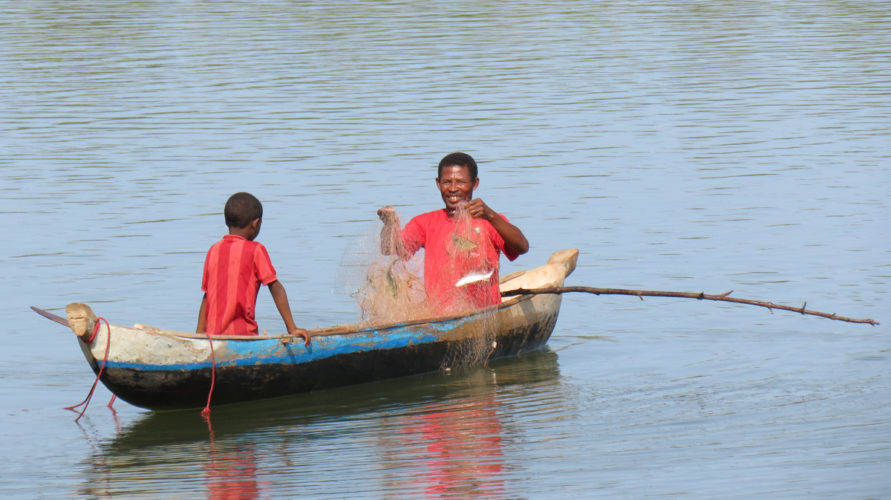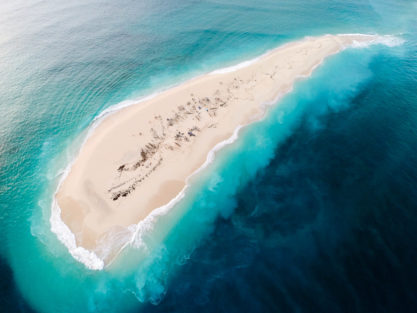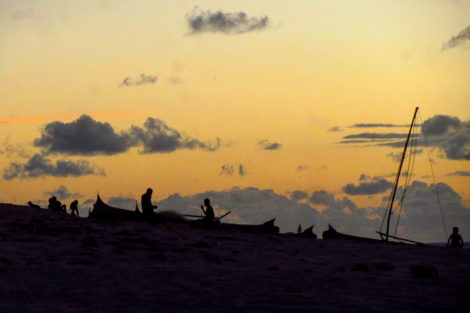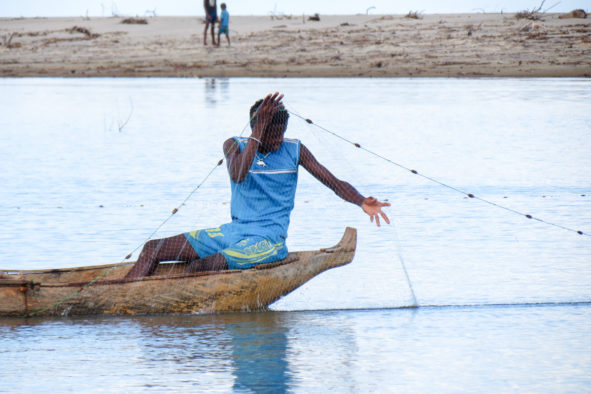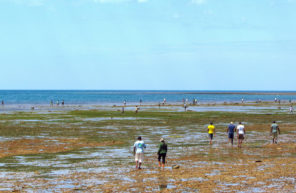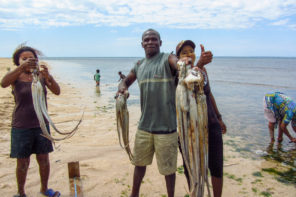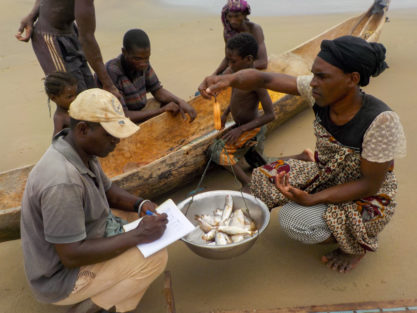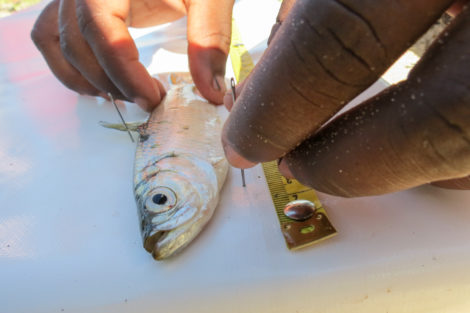I sometimes fished in Soahany before the closure, but today I had my best catch” said Soafiavy with a grin, as he pulled his pirogue onto the shore.
He was soon joined by other fishers returning from the newly reopened fishing ground, but not everyone had enjoyed the same success; in fact, some pirogues were practically empty. Despite this, enthusiasm seemed to be high, and every fisher arriving had a new idea about how to improve the management strategy next time.
“A four-month closure will never be enough to have a productive fishery in this channel,” Jean de Dieu said as he packed up his nets. “I think it would take more than six months to show real improvement.”
Chatting with his fellow fishers in the shade of the mangrove trees, Rufin expressed a different view. “I think that fishing at night or in the morning gets a better catch in Soahany than fishing during the day, and that explains why our opening day catch has been low.”
“The area of the current closure is very small,” Manakay mused as he watched the data collectors record his catch. “The channel is large, and I think that if we want better catch then we have to increase the protected area.”
It’s not every day that unexceptional fishing trips inspire such thoughtful debate, but times are changing for the communities in the Barren Isles archipelago.
Located off the west coast of Madagascar, the Barren Isles are remote, and strikingly beautiful, but seem pretty inhospitable at first glance. Many of the isles have no fresh water or vegetation, and at spring tide some are completely submerged!
In fact, the archipelago supports the livelihoods of over 4,000 traditional migrant fishers, attracted by the abundant marine life of the surrounding coral reefs, seamounts, mangroves and seagrass meadows.
To strengthen the rights of these fishing communities and conserve the remarkable resident wildlife populations, Blue Ventures and local communities worked together to secure protected status for the Barren Isles archipelago in 2014, and it is now the Indian Ocean’s largest locally managed marine area (LMMA).
The LMMA is co-managed by a group of locally elected leaders from the fishing communities, officially known as the Vezo Miray Nosy Barren Association (VMNB), and these leaders have been instrumental in championing a fisheries management strategy in their communities called periodic fishery closures. These short-term closures protect targeted marine species or areas of reef to increase their productivity, with the aim of boosting the catch and income of the local fishing communities upon re-opening.
BV has been supporting communities to manage their fisheries since 2003, in Madagascar and elsewhere in the Indian Ocean, and we have learnt that full community engagement provides the foundation for successful fisheries management.Representatives of the VMNB heard success stories of periodic octopus fishery closures in the southwest of the country during forums facilitated by MIHARI, the national LMMA network. Inspired by these stories, they decided to initiate the first locally led closures in the Barren Isles LMMA, and asked Blue Ventures (BV) for technical support.
BV has been supporting communities to manage their fisheries since 2003, in Madagascar and elsewhere in the Indian Ocean, and we have learnt that full community engagement provides the foundation for successful fisheries management.
With this in mind, we facilitated a series of community meetings, in which the VMNB presented their proposal for periodic closures, and community members contributed to the discussions on closure length, location and boundaries. This participatory process resulted in the establishment of the first periodic fishery closures in the Barren Isles, a landmark for community-led management in the region.
This series of seven pilot closures was designed to test the strategy without significant risk to the income of the managing communities. For the first two closures in May 2018, this was achieved by targeting octopus on the islands of Nosy Marify and Nosy Maroantaly, where it is a less economically important species. The other five closures targeted all species, but were located in seldom-visited fishing areas such as the Soahany channel.
All of the closures were monitored by community-based data collectors, trained by BV to record catch data and the perceptions of the managing communities. These data were then analysed and shared with the managing communities, and with some other communities in the region who had expressed interest.
And what did the data show?
There were some positive results following the two closures that targeted octopus. Upon reopening, individual octopus caught within the closure area were significantly larger and heavier than those caught in the control area (a similar fishing ground that had no restriction on octopus harvesting during the same time period).
Anecdotally, many of the fishers were enthusiastic in their assessments of these two closures, with a fisher from Nosy Marify saying that he had “never seen such big octopus in this area.”
However, no significant impact on total catch was found in any of the seven closures upon reopening.
There were some mitigating factors. There was only a small amount of baseline data for comparison, and some of the opening days had poor weather, resulting in limited fishing and fewer data collectors to record the catch.
These results could well have dampened community enthusiasm for marine management, but in fact their engagement actually increased! Keen debate at the data dissemination meetings showed the fishers’ willingness to continue refining the closure strategy rather than abandoning it.
Communities who engage in periodic fishery closures often report a wide diversity of benefits beyond their catch results.
This was reflected in their management decisions the following year. All seven managing communities closed fishing areas again in 2019, with each closure adapted either in location, duration or with additional restrictions to try to increase their chances of success. Not just that, but four new communities also decided to close fishing areas for the first time!
This is not an uncommon story. Communities who engage in periodic fishery closures often report a wide diversity of benefits beyond their catch results.
In the case of the Barren Isles, community members were trained to collect and interpret data, giving them new skills and a better understanding of their fishery. This, in combination with the participatory nature of the management strategy, inspired a sense of ownership and greater confidence in making management decisions.
Hopefully these management decisions will reap rewards on future opening days, but regardless, the fishers of the Barren Isles are ready to learn, adapt and move forward.
Learn more about Blue Ventures’ work in the Barren Isles archipelago, or about the broader impacts of community engagement in fisheries management.
Our work in the Barren Isles is made possible thanks to generous support from the Critical Ecosystem Partnership Fund.


